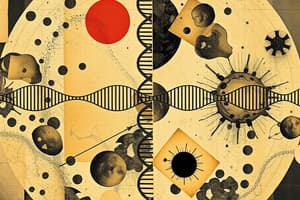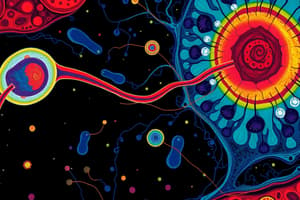Podcast
Questions and Answers
In what type of organs are the cells that enter meiosis I found?
In what type of organs are the cells that enter meiosis I found?
The sex cells
What event must take place during interphase before a cell proceeds to division?
What event must take place during interphase before a cell proceeds to division?
DNA replication
What two structures make up a single replicated chromosome?
What two structures make up a single replicated chromosome?
Sister chromatids
How many replicated chromosomes does the cell contain during prophase?
How many replicated chromosomes does the cell contain during prophase?
At which stage in meiosis I do the pairs of homologous chromosomes come together?
At which stage in meiosis I do the pairs of homologous chromosomes come together?
Once the chromosomes have formed a pair, what are they called?
Once the chromosomes have formed a pair, what are they called?
How many replicated chromosomes are in each of the cells produced at the end of meiosis I?
How many replicated chromosomes are in each of the cells produced at the end of meiosis I?
Cells with a full set of chromosomes are referred to as ______, whereas cells with half the chromosomes are ______.
Cells with a full set of chromosomes are referred to as ______, whereas cells with half the chromosomes are ______.
At which stages of meiosis I are the cells diploid and at which stages are they haploid?
At which stages of meiosis I are the cells diploid and at which stages are they haploid?
Which statement correctly describes the relationship between the cells at the end of telophase I and the original cell?
Which statement correctly describes the relationship between the cells at the end of telophase I and the original cell?
Will the cells at the end of telophase I be genetically identical to each other?
Will the cells at the end of telophase I be genetically identical to each other?
Where did each of the cells come from that started meiosis II?
Where did each of the cells come from that started meiosis II?
Which structures separate during anaphase I in meiosis I?
Which structures separate during anaphase I in meiosis I?
Which structures separate during anaphase II in meiosis II?
Which structures separate during anaphase II in meiosis II?
At the end of meiosis II, are the four daughter cells haploid or diploid?
At the end of meiosis II, are the four daughter cells haploid or diploid?
Which statement describes the relationship between the cells at the end of meiosis II and the original cell?
Which statement describes the relationship between the cells at the end of meiosis II and the original cell?
What is the name given to the cells produced at the end of meiosis I in males?
What is the name given to the cells produced at the end of meiosis I in males?
What is the name given to the cells produced at the end of meiosis I in females?
What is the name given to the cells produced at the end of meiosis I in females?
What cells are produced at the end of meiosis II in males?
What cells are produced at the end of meiosis II in males?
What do spermatids eventually become?
What do spermatids eventually become?
Before fertilization, what happens to the secondary oocyte?
Before fertilization, what happens to the secondary oocyte?
During fertilization, which two cells come together?
During fertilization, which two cells come together?
Why does the secondary oocyte divide unevenly during meiosis II?
Why does the secondary oocyte divide unevenly during meiosis II?
What is the ploidy of the zygote produced by fertilization?
What is the ploidy of the zygote produced by fertilization?
What would the ploidy of the zygote be if egg and sperm were produced by mitosis?
What would the ploidy of the zygote be if egg and sperm were produced by mitosis?
Explain the origin of the chromosomes found in the zygote.
Explain the origin of the chromosomes found in the zygote.
At which stage of meiosis are the chromosomes in Model 4?
At which stage of meiosis are the chromosomes in Model 4?
What are the crossover points called when homologous chromosomes come together?
What are the crossover points called when homologous chromosomes come together?
What happens to the chromatids during crossover?
What happens to the chromatids during crossover?
What phrase describes the chromatids after crossing over occurs?
What phrase describes the chromatids after crossing over occurs?
Are the genes on a recombinant chromatid the same as the original chromatid?
Are the genes on a recombinant chromatid the same as the original chromatid?
Are the alleles on a recombinant chromatid the same as the original chromatid?
Are the alleles on a recombinant chromatid the same as the original chromatid?
Is either arrangement equally likely during the formation of tetrads in late prophase I?
Is either arrangement equally likely during the formation of tetrads in late prophase I?
If there were three sets of homologous chromosomes, how many possible arrangements would there be for the tetrads?
If there were three sets of homologous chromosomes, how many possible arrangements would there be for the tetrads?
Calculate the number of possible genetic combinations due to independent assortment.
Calculate the number of possible genetic combinations due to independent assortment.
Explain how meiotic events and random fertilization lead to genetic variation.
Explain how meiotic events and random fertilization lead to genetic variation.
Flashcards
Meiosis
Meiosis
Cell division in sex cells (gametes) that results in four haploid daughter cells.
DNA Replication
DNA Replication
The process where DNA is copied before cell division begins, resulting in two sister chromatids.
Sister Chromatids
Sister Chromatids
Two identical copies of a chromosome connected at the centromere.
Prophase I
Prophase I
Signup and view all the flashcards
Tetrad Formation
Tetrad Formation
Signup and view all the flashcards
Diploid
Diploid
Signup and view all the flashcards
Haploid
Haploid
Signup and view all the flashcards
Chromosome Separation in Meiosis
Chromosome Separation in Meiosis
Signup and view all the flashcards
Haploid Daughter Cells
Haploid Daughter Cells
Signup and view all the flashcards
Spermocyte
Spermocyte
Signup and view all the flashcards
Spermatids
Spermatids
Signup and view all the flashcards
Secondary Oocyte
Secondary Oocyte
Signup and view all the flashcards
Ovum
Ovum
Signup and view all the flashcards
Polar Body
Polar Body
Signup and view all the flashcards
Fertilization
Fertilization
Signup and view all the flashcards
Zygote
Zygote
Signup and view all the flashcards
Tetraploid
Tetraploid
Signup and view all the flashcards
Chiasmata
Chiasmata
Signup and view all the flashcards
Recombinant Chromatids
Recombinant Chromatids
Signup and view all the flashcards
Independent Assortment
Independent Assortment
Signup and view all the flashcards
New Allele Combinations
New Allele Combinations
Signup and view all the flashcards
Genetic Diversity
Genetic Diversity
Signup and view all the flashcards
Study Notes
Meiosis Overview
- Meiosis occurs in sex cells (gametes).
- DNA replication is necessary before cell division begins.
- Replicated chromosomes consist of two sister chromatids.
Stages of Meiosis I
- During prophase I, cells contain four replicated chromosomes.
- Homologous chromosomes pair up in late prophase I, forming tetrads.
- At the end of meiosis I, two cells are formed, each containing two replicated chromosomes.
- Cells are diploid during prophase, metaphase, and anaphase, while they become haploid in telophase after splitting.
- The relationship between telophase I cells and the original cell involves each having half the genetic information.
Genetic Variation
- Homologous pairs at telophase I are not genetically identical because they carry different alleles for the same genes.
- In meiosis II, homologous chromosomes separate first in anaphase I, followed by sister chromatids in anaphase II.
- At the end of meiosis II, there are four haploid daughter cells, each with one set of chromosomes.
Male and Female Gamete Production
- Males produce spermocyte at the end of meiosis I, which becomes spermatids after meiosis II.
- Females yield secondary oocyte at the end of meiosis I, which can proceed to meiosis II.
- The process of meiosis II in females results in one ovum and a polar body that degenerates.
Fertilization Process
- Fertilization involves the fusion of a mature sperm and a secondary oocyte.
- The resulting zygote is diploid, with half of its homologous pairs from each parent.
Impact of Mitosis on Ploidy
- If gametes formed by mitosis, the zygote would be tetraploid (four sets of chromosomes).
- Each subsequent generation would also double in ploidy.
Chromosomal Dynamics
- Each zygote chromosome originates from a homologous pair, with contributions from both parents.
- During prophase I, chromosomes may undergo crossing over at points called chiasmata, exchanging DNA segments.
- Post-crossover chromatids are referred to as recombinant chromatids; they contain the same genes but potentially different alleles.
Independent Assortment
- In late prophase I, chromosomes can arrange in various configurations, leading to multiple genetic combinations.
- For three sets of homologous chromosomes, eight tetrad arrangements are possible.
- Independent assortment during metaphase I results in 8,388,608 possible genetic combinations due to the orientation of chromosome pairs.
Genetic Variation Outcomes
- Independent assortment mixes homologous chromosome pairs.
- Crossing over creates new allele combinations.
- Random fertilization brings together diverse maternal and paternal chromosomes, contributing to genetic diversity.
Studying That Suits You
Use AI to generate personalized quizzes and flashcards to suit your learning preferences.




